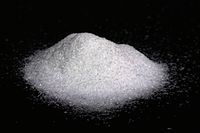Monosodium
 |
|
 |
|
| Names | |
|---|---|
|
IUPAC name
Sodium 2-aminopentanedioate
|
|
| Identifiers | |
|
142-47-2 |
|
| 3D model (Jmol) | Interactive image |
| ChemSpider |
76943 |
| ECHA InfoCard | 100.005.035 |
| EC Number | 205-538-1 |
| E number | E621 (flavour enhancer) |
| PubChem | 85314 |
| UNII |
C3C196L9FG |
|
|
|
|
| Properties | |
| C5H8NO4Na | |
| Molar mass | 169.111 g/mol |
| Appearance | White crystalline powder |
| Melting point | 232 °C (450 °F; 505 K) |
| 740 g/L | |
| Hazards | |
| NFPA 704 | |
| Lethal dose or concentration (LD, LC): | |
|
LD50 (median dose)
|
15800 mg/kg (oral, rat) |
|
Except where otherwise noted, data are given for materials in their standard state (at 25 °C [77 °F], 100 kPa).
|
|
|
|
|
| Infobox references | |
Monosodium glutamate (MSG, also known as sodium glutamate) is the sodium salt of glutamic acid, one of the most abundant naturally occurring non-essential amino acids. Monosodium glutamate is found naturally in tomatoes, cheese and other foods.
MSG is used in the food industry as a flavor enhancer with an umami taste that intensifies the meaty, savory flavor of food, as naturally occurring glutamate does in foods such as stews and meat soups. It was first prepared in 1908 by Japanese biochemist Kikunae Ikeda, who was trying to isolate and duplicate the savory taste of kombu, an edible seaweed used as a base for many Japanese soups. MSG as a flavor enhancer balances, blends, and rounds the perception of other tastes.
The U.S. Food and Drug Administration has given MSG its generally recognized as safe (GRAS) designation. A popular belief is that large doses of MSG can cause headaches and other feelings of discomfort, known as "Chinese restaurant syndrome," but double-blind tests fail to find evidence of such a reaction. The European Union classifies it as a food additive permitted in certain foods and subject to quantitative limits. MSG has the HS code 29224220 and the E number E621.
Pure MSG is reported not to have a pleasant taste until it is combined with a savory aroma. The basic sensory function of MSG is attributed to its ability to enhance savory taste-active compounds when added in the proper concentration. The optimum concentration varies by food; in clear soup, the pleasure score rapidly falls with the addition of more than one gram of MSG per 100 mL.
...
Wikipedia

